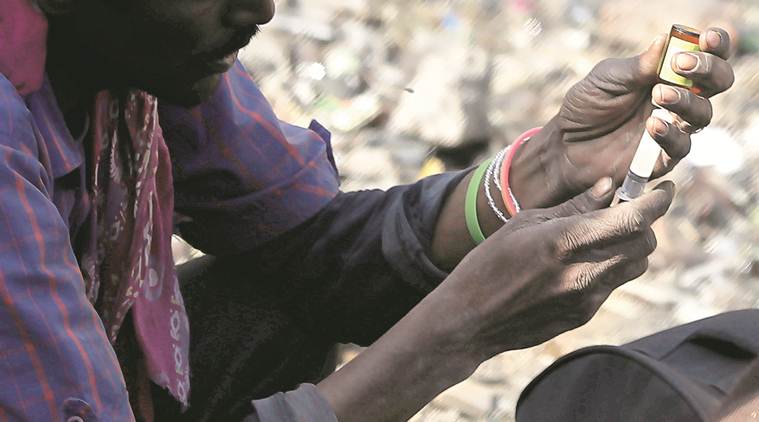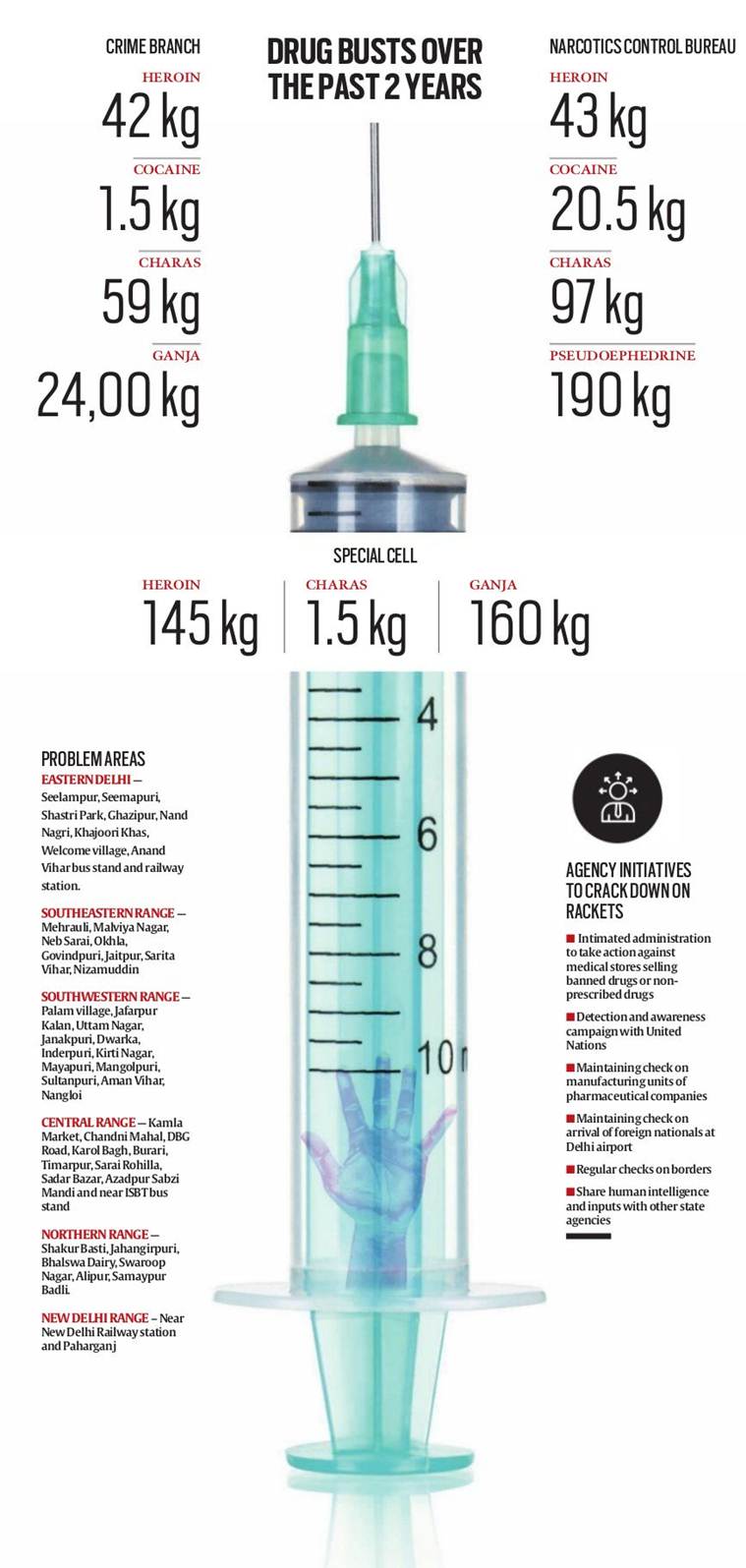Stay updated with the latest - Click here to follow us on Instagram
On a high: How Delhi has become a hotbed of drug smuggling
From struggles faced by heroin addicts to youth in the capital getting caught in the drug net, The Indian Express traces how Delhi has become a hotbed of drug smuggling
 A 22-year-old resident of east Delhi knows first-hand what it is like to fall into the trap at a young age. (Express Photo by Abhinav Saha)
A 22-year-old resident of east Delhi knows first-hand what it is like to fall into the trap at a young age. (Express Photo by Abhinav Saha)
Cut, samaan or maal — these are words that a 38-year-old real estate broker wants to forget. What started as an experiment with a pinch of heroin 14 years ago has now hijacked his life. Lodged at a south Delhi de-addiction centre for the sixth time in seven years, the father of two is trying to get rid of a habit that has cost him family ties and his business. “I started abusing drugs when I was in Class X. The guard in my school gave it to me, saying it was ‘bhole ki booti’. I don’t remember if it was heroin, charas or ganja,” he says.
Clad in a T-shirt and jeans, he sits in a room at the de-addiction centre for a counselling session. “I am very familiar with this place; the doctors and staff know me. But this is the last time I want to come here,” he says.
Over the past three years, police sources say, the demand for drugs, especially cocaine and heroin, has been increasing in the city. While the former is out of reach for many due to its high cost, heroin — especially its adulterated version known as smack — is much more accessible.
The cost of 1 kg heroin in the international market is about Rs 4 crore. In Delhi, as all over the world, the drug is adulterated — or cut — using sugar, coffee and several compounds. One gram is sold in Delhi for about Rs 200-Rs 300 in various hotspots, which include JJ clusters and parks. Cocaine, on the other hand, is 15 to 20 times more expensive. Brown sugar or smack is very common in Delhi, mostly among youngsters. It is often mixed with various pharmaceutical drugs that are illegally sold over the counter. Addicts inhale, snort or inject the drug.

In February this year, the Delhi Police busted a gang in Shahdara’s Seemapuri area and recovered 273.45 grams of smack worth Rs 7.5 lakh in the international market. The gang would sell 2,000 packets (each containing 1 gram heroin) of the contraband in a single day. The peddlers got their supply of heroin from Bareilly in Uttar Pradesh. Police had claimed that the accused were selling heroin packets to almost 4,000-5,000 boys in the area. In the case, police had identified 18 boys who were addicted to heroin. Three of them were minors.
A 22-year-old resident of east Delhi knows first-hand what it is like to fall into the trap at a young age. He says he has to inject 10 ml of a mixture of heroin and anti-allergens into his veins every day, else he experiences severe withdrawal symptoms such as restlessness, aches and pains in the bones, insomnia, diarrhea, and vomiting.
“I started smoking cigarettes when I was in Class IX. I quickly moved on to beer, whisky, ganja, charas and eventually cut smack. I can buy a day’s fix in a small pouch for Rs 200. I mix it with Avil (anti-allergic medicine). Ten ml of the mixture is sufficient for me,” he says.
He, too, has been in and out of de-addiction centres. “This is my fourth time at the centre. After each three-month course, I end up in the same environment — the same friends and the same temptations. I want to get rid of this habit,” he says.
A transit point
Over the years, owing to accessibility and relative anonymity, Delhi has become a transit point for international drug peddlers. Police sources say that presently there are three big hubs of heroin — southwest Asia, southeast Asia and India.
Heroin is an opioid – a drug derived from opium. Cultivation of poppy for opium is allowed in some parts of India, Turkey and Australia. While countries such as Pakistan and Afghanistan have banned the cultivation, the plant is still grown extensively in some areas, police say. Opium is used to make morphine — a purified form of which is used to make a strong painkiller. Morphine is also used to make heroin.
In India, police say, heroin comes from Rajasthan’s Kota, Jhalawar, Bara, Chittorgarh, Pratapgarh and Udaipur, Madhya Pradesh’s Bhawani, Mandi, Mandsaur, Indore and Neemuch and Uttar Pradesh’s Bareilly, Barabanki and Badaun and some parts of Jharkhand. Police sources say heroin is also smuggled in from Afghanistan and Pakistan via Amritsar. Cocaine — extracted from the leaves of Coca plants — comes to Delhi from west African countries via Mumbai and Goa, police say. Police have also noticed the increasing trend of involvement of foreign nationals and women in the drug trade. According to officials at the Narcotics Control Bureau (NCB), women belonging to middle class families take to trafficking as their relatives are involved in the trade.
Director of the Delhi Zonal Unit (NCB), Madho Singh, told The Indian Express that they have identified two routes via which heroin is supplied to Delhi and other parts of India — border route and air route.
“Due to tension at the border, smuggling via this route has decreased of late. But a new trend is being noticed — drugs are being smuggled by air passengers. The carrier swallows capsules filled with the drugs. Once they land in the country, the drugs are extracted. However, our intelligence network helps us nab such carriers,” says Singh, adding that the unit is working towards procuring a full body scanner at the Indira Gandhi International Airport.
Sources say the government has asked security agencies to create a database of persons who have been arrested in connection with drug trade. The government has also directed that information about such peddlers or rackets be shared between the agencies.
Deputy Commissioner of Police (narcotics and crime) Rajesh Deo told The Indian Express, “We are in the process of developing more human intelligence to delve deeper into the peddling racket. We are developing various mechanisms for this purpose. Low income areas are majorly affected by drug peddling and we will soon launch awareness programmes there.”
Rise of party drugs
Besides heroin, police say the most commonly abused drugs in Delhi are ganja (marijuana), charas (cannabis), cocaine, opium, buprenorphine, nitrazepam, phenegran, diazepam, mandrax, amphetamine, morphine, pentazocin, pseudoephedrine and codine. “Use of smack and ganja gained impetus as it is cheaper than other drugs. Most of the addicts are street children, people living in shelters and adolescents from the lower classes,” says a police officer, who works in the narcotics department of Delhi Police.
In the recent past, another trend has emerged — an increase in the use of party drugs such as LSD (acid/blotter), MDMA (ecstasy/eve/lover’s speed, peace), GHB (liquid ecstasy/scoop) and mephedrone (meow meow) in the capital.
Police sources say these drugs are being used in tandem with alcohol — drugs and alcohol are taken alternatively to give a ‘high’ which lasts for several hours. “The alternative dosage of alcohol and the drug has a spiraling effect, which is further fuelled by high-pitch trance music at rave parties. Though such parties are not common in Delhi, the increase in the type and quantity of party drugs in Delhi is dangerous,” says an officer.
Another officer says the dog squad unit will soon see the addition of two new sniffer dogs, who will be trained exclusively for the purpose of detecting drugs. “The squad has dogs which are trained to detect drugs as well as explosives, but we need to train dogs to sniff out drugs exclusively,” he says.
Going clean
According to doctors, heroin is highly addictive — using the drug a few times is all it takes for people to get addicted. Quitting is tough because of the painful withdrawal symptoms.
The real estate dealer testifies to this. “I am married and have two young children. Most people don’t understand the struggle. I don’t want to live in this drug-induced haze. Even my children have repeatedly asked me to quit this habit. It is heartbreaking. I want to lead a good life. I keep joining de-addiction centres but I cannot remain sober for long. The urge to use is too strong,” he says.
He says that he had reported to police and other agencies about the illegal sale of heroin in his area to no avail. “At least 40 per cent of youngsters in my area are addicts. Many times, I have alerted police about the trade but nothing has been done. Also, tablets and medicines (used to cut the drug) are being easily sold over the counter in medical stores,” he says.
According to a doctor at the centre, the company an addict keeps and the environment he lives in during and after treatment are important. “Once a patient completes the treatment, he should avoid coming in contact with the same circle of friends or people with whom he used to take drugs” says the doctor. He adds, “While some get over the addiction soon after the first treatment, others require multiple treatments.”
Talking about how the misuse of pharmaceutical products is on the rise in the capital, another doctor says people mix a small quantity of heroin with readily-available medicines from pharmacies.
Police, however, say misuse of pharmaceutical products comes under the Drugs and Cosmetics Act, and only the government has the power to take action. “We can only inform the administration, which we always do when such an activity comes to our notice. We can only seize, arrest and investigate the banned drugs under the NDPS (Narcotic Drugs and Psychotropic Substances) Act,” a police officer says. Under the law, a person booked under the Act may face imprisonment up to 10 years or more. The quantum of punishment is also based on the quantity of banned drugs recovered from his or her possession.
From Afghanistan to the capital
March 2017
Special Cell arrests two, recover heroin worth Rs 8 crore. According to Special Cell sources, the accused were part of an international drug ring with origins in Afghanistan and a trafficking network spanning Pakistan and several parts of India.
January 2017
Acting on information, NCB intercepts an Afghan national travelling from Herat to New Delhi via Kabul. About 90 capsules of heroin extracted from his stomach.







